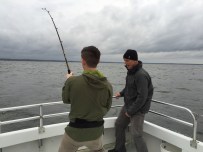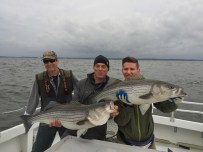The Chesapeake Bay is quiet in early April. The weather is still chilly for boating, and on a weekday morning at Herrington Harbor in Tracys Landing, Maryland, there is barely a soul to disturb the morning fog.
I’m here for a fishing expedition with Jeremy Wade. Wade is the host of River Monsters, a show on Animal Planet that follows Wade around the world as he hunts down the most terrifying and vicious freshwater fish on earth.
Or at least, that was how it worked for the first seven seasons. Season 8, which premieres Thursday night on Animal Planet at 9 p.m., will follow Wade into the ocean. (There are only so many monsters to hunt in the rivers of the world.) River Monsters, which has been a massive success for Animal Planet, is part fishing show, part detective procedural, part MythBusters — Wade shows up in a new locale every episode and investigates a mythical beast that is said to haunt a body of water. He follows clues, tracks down leads, and then, by the end of each episode, solves the case — by reeling in a terrifying, toothed thing that will give you nightmares.
We’re not here today to catch a river monster though. We’re here so Wade can take a break from promoting Season 8 and get out on the water to do what he loves most. (The promotion machine never stops, though, which is how I found myself on the boat with him.)
Wade doesn’t seem too distressed about having a journalist interloper on his morning expedition into the Chesapeake Bay. We meet just past dawn; Wade, dressed in gray Simms waterproof pants, multiple thermal layers, and a rain jacket, is layered for rainy weather, which is scheduled to arrive late morning.
We’re joined by Andie Clare, Wade’s producer who accompanies him on many shoots. She and Wade are both quiet and polite and English, and both — like myself, to be honest — are a little groggy in the murky morning.
Our captain Shawn Gibson shows up, and we clamber in his big truck and head out to his boat, which is called Wound Tight. We walk the dock and climb aboard — it’s the cleanest fishing boat I’ve ever been on. The whole thing is spotless, the rods and lures look unused. It is early in the season, of course, but you can tell Gibson and his first mate Scott Verdin have a real desire to impress Wade, who you can tell both revere. (Verdin more than once tells me, as an aside, that Wade is a “true pro,” which you can tell is the highest form of praise he can give someone.)
Gibson is worried about the weather, so we head out quickly into the open water. The whole process of getting picked up, in the boat, and out on the water takes maybe 15 minutes … it’s the most efficient fishing trip I’ve ever been on.
The captain explains how we’ll be fishing that day, a method that’s at once genius and delightfully low-tech. The guys have two wooden planer boards, which are little raft-like objects made of three thin strips of wood connected by iron rods. (You can see an example here.) The captain and mate toss the boards into the water, each connected to a line, and the boards fan out to each side of the boat, allowing us to troll off both sides with ease. Later in the season they’ll run 10 or 15 lines off each side, but we’re technically out here before the season starts, and six lines is all we get — though some of the lines have two lures on them.
First mate Verdin is explaining all this when Captain Gibson starts laughing and screams “Fish on!” He’s barely put one line in the water — he hadn’t even hooked it up to the line attached to the planer board yet. In and a fish on. Wade, demure and polite up to this moment, leaps into action. He grabs the rod from Gibson, and then walks steadily to the back of the boat. Gibson grabs a Velcro belt and ties it around Wade’s waist — the belt has a fixture that allows you to anchor the rod against you without digging into your leg or groin.
The transformation over Wade is quick but complete — the rugged, dignified Englishman I was speaking to moments before has been replaced by a giddy child. He laughs, looks around.
“Can you believe that?” he says. “First line. Barely wet.”
He calls me over to stand next to him while he brings in the fish.
“See how I don’t force it,” he says, with the authority and good cheer of a schoolteacher. “I pull up, never letting the tension go. When the fish relaxes, that’s when I bring the rod down and reel in. But you don’t rush it. If it runs, you let it run. But pull up … then reel. You never want to let the rod go below 90 degrees.”
Soon enough he brings in his haul — a 38-inch rockfish, which is what they call striped bass in the Chesapeake Bay. With a toothy grin he holds it up for a photo, then gently puts the massive fish back into the water.
After his haul, he’s still all smiles.
“It’s different than river fishing, you know? This last season we went out into the ocean, and it’s different fishing. But the thrill is still there,” he says. “And I’ve learned that there is a skill. With rivers, you don’t have a lot of room to work, and with the bigger fish that I’m catching, you might have just a few feet to work with. But here in a bigger body of water, there still is knowing where to go, what lures to use, where the fish will be.”
Wade was a fisherman long before he was ever on camera. After studying zoology in school, he worked as a secondary school biology teacher for a time in England. He started traveling and writing about his travels, first in publications and then eventually in the novel Somewhere Down the Crazy River, which he co-wrote with Paul Arthur Boot. From there, more writing, more documentaries … and then a shot with River Monsters, which surprised just about everyone involved when it became the most popular show on Animal Planet.
After our first strike, there’s a lull, but Wade doesn’t switch off. As Gibson and Verdin move around the boat, Wade stalks them, asking questions about the lures they’re using, the techniques, the length of the season, the different fish in the bay. He’s soaking up as much information as he can. By the end of the day, he’ll have helped out with or attempted to learn almost every task on the boat — cleaning the lures (they use a simple hairbrush), hauling the fish in with a net, setting out the lines, adjusting the tension on reels. While the rest of us on board are happy to sit back and wait to reel something in, Wade is busy — he’s there to learn, and he’s there to work.
“It’s a joy to be out here without a production crew,” he says. “Usually we have two boats, and if I get a fish on, it’s Get the camera ready. Focus the shot. Make sure we’re standing in the right place.”
Clare chimes in: “Try it with his sunglasses off.”
He laughs. “Try it with his sunglasses off, exactly. And here I don’t have to worry about all that. I can just appreciate the water, and the fish.”
An hour into the trip, and the weather is starting to turn. We can see storm clouds in the distance, out across the bay. It starts to rain lightly. The captain says we should think about heading in, but Wade is undeterred — Clare hasn’t brought in a fish yet, and a little rain isn’t going to stop us.
Moments later, we get our wish. A big bite, “Fish on!” and Clare is reeling in her fish. As she’s posing for a photo, though, another bite happens. This one is mine.
I grab the rod and start reeling in. I’ve already caught one today, and this one feels easier, lighter. Wade walks over and starts coaching me, but I’m feeling more confident. Then, out of nowhere, the rod yanks down. This is different. I feel like I can barely hold on to it. I widen my stance and hold on, my thighs and right arm burning under the strain.
Wade smiles and begins coaching me, walking me through each yank on the reel.
“That’s it. Good. Not too much. Don’t force it. This will be a big one. Yes. Good. Pull up, there you go,” he says, nodding. My eyes remain on the reel. I worry, just for a moment, that one more big pull and I’ll go in the water. “Pull up, good. Get it up to 90 degrees. Perfect. Now you reel. Don’t rush it. We’ve got all the time.”
I pull and pull, reel in when I can. I’m growing fatigued, but Wade is right with me, coaching me, pushing me along.
The captain runs over, sees the strain on the rod.
“This could be a huge one,” he says.
Eventually, with the last of my strength, I get the line close enough to the boat that we can see a fish. I back up, slowly walking with the rod raised high, allowing Wade and Gibson to get in front of me with a net. My arms are about to fail.
“There’s two of them!” Wade calls out.
I’d hooked two rockfish on the two lures on the line. One 40 inches long, the other 38, a good 75 pounds of fish between them. They haul them up, and Wade turns to me laughing. This is a man who has caught a freshwater sawfish in Australia, who has gone down the Congo and hunted for the illusive “demon fish”, searched for the flesh-eaters of the Amazon and gone head-to-head with the longfin eel of New Zealand, and his eyes are filled with wonder.
“What a catch,” he says.












